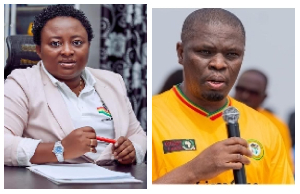Amansie–South was only recently carved out from Amansie- West with its capital at Mansoh-Nkwanta.
This article discusses recent developments concerning its road network that have given the people a big glimmer of hope.
Amansie-North with its capital at Mansoh- Nkwanta and Amansie- South with its capital at Adubia constitute the Amansie- West that form the food basket and gold resources of Ashanti. Mansoh, ever since it was created in the days of Nana Osei Tutu (1660-1707), has ever been synonymous with gold production up to date.
Its forests and cocoa farms are, therefore, littered with shallow gold pits (Nkrom in Twi). Little wonder there have been and there are still great gold mining companies operating in the area, including Amansie Resources Limited in the past and currently the Asanco Mining Company Limited.
The area abounds in all types of timber species and wood that provide shades to protect the cocoa from excessive sunshine to enable them to produce abundant fruits. In addition, rivers and rivulets also abound in its forests to make the soil very fertile.
Another favour by God is its wetlands (Wora in Twi). They are very abundant in the area. Little wonder Amansie, besides the commercial production of cocoa, also produces foodstuff such as cereals (rice, corn), plantain, and tubers (yam, cocoyam). Concerning its timber, you can see about three truckloads of heavy timber coming from as far as Edwenase which shares a common border with Denkyira.
Notwithstanding these economic benefits to the nation, Mansoh, as a whole, has suffered from poor road fractures that are riddled with pot-holes that become very slippery during the raining seasons and very dusty in the dry seasons. Since the dawn of the fourth republic in 1992, I have consistently written on the above subject in the Times to past governments, but to no avail.
It, therefore, came as a big surprise to me and many people when, on visiting my village at Kumpese last year, I suddenly found myself riding in comfort on an excellent and well-tarred road from a checkpoint at Agroyesum to my village.
The major road network of the newly created Amansie South, therefore, begins from Mim –Nkwanta (Nkwanta means Junction in Twi). From this junction, where the police checkpoint is sited with women selling plantain chips and all sorts of minerals, you drive down a steep ground where, quite often, heavily –loaded timber trucks moving up the steep to the junction get stuck.
The untarred, bumpy, and dusty road from the junction continues to Mim, the next town. About some metres ahead is the Ankam Junction with its branch road leading to the Ankam Township. Continuing on the major road, you drive down a small steep of land which can be heavily flooded during heavy rains.
You then continue driving on the worst part of the untarred road with vast acreage of rehabilitated galamsey lands on both the right and left sides. Before negotiating a curve on the left side of the road, where a newly constructed Mosque has been built, two smaller bridges have been rehabilitated and are now in good condition.
After that, you continue to Agroyesum Township itself till you reach the market followed by the Catholic Hospital on the left. This is the major hospital in the area that caters to the health needs of residents of Amansie and people from as far away as the Ivory Coast. You continue driving along a poor road till you reach a police checkpoint not far from the hospital. From this point onwards the road is well tarred and will need a second coating to make it firmer and, hence last longer.
After climbing up a small hilly ground, you enter Nkontene. The tarred road continues to Ayirebikrom then to Kensere Nkwanta then to Adubia, the newly–created district capital of Amansie- South. On the outskirt of the town on your right is the new Administrative Block constructed about a couple of years ago under the NPP Government.
I understand a new hospital and staff bungalows are being constructed not far from the Administrative block. As you drive towards the centre of the town the Mansoman Secondary School is on your right. From the school, the tarred road takes you to the Adubia Health Clinic. Cars and Lorries then stop at a spot where passengers alight, while others embark. An arterial road on the right climbs a hill and leads to Asuadee and from there to Agyagyekrom with a market. The latter is on the Mansoh- Nkwanta to the Abore road. From Adubia to Agyakekrom took only about ten minutes, while previously it would take about thirty minutes when the road was in poor condition.
Continuing from Adubia along the major road, you drive past the well-built police station on the left followed by a hotel. From there you drive along a smooth road to Nkyankomasi then to Kumpese, where the road branches into two: The right one leads to Abiram which is tarred up to a barrier manned by Asanco. From that checkpoint to Subinso and beyond up to another checkpoint is untarred. From the latter to Adubiaso to Keniago have all been tarred. Continuing from the road at the Kumpese junction you drive along an untarred road to Akwasiso, the next town. From Akwasiso to Koninase to Nkran to Dadease to Datano to Wonnipaninia due, all untarred. But from an arterial road on the left side of Akwasiso, the road is well-tarred to Afedee, till you reach Watereso. See the attached figure.
The following are my recommendations because 2024 is an election year in which a significant portion of the government’s time will be devoted to the election campaign just as all the other parties will be doing. First, the road from the Mim junction to the police checkpoint at Agroyesum must be completed as a matter of urgency. This will be of immense help to the people in addition to making the tarred road continuous from Mim to Kumpese. Besides, it will make the people more appreciative than if left half done.
Secondly, the remaining little portion of the untarred road from Kumpese to Subinso must also be urgently tarred to bring the work to a good measure of completion.
Thirdly, if there is sufficient time to complete the rest of the untarred road from Kumpese to Watereso then that will be most excellent.
To the President, Nana Akufo Addo, the MP, Frimpong Mansoh, and the DCE, Clement Opoku, I will say more grease to your elbows.
I will end on the Akan proverb: “If you have killed us then bury us” meaning that if the government has been so good by doing us a good deed then he should try and complete it.
Conclusion:
We end up in prayers for the good people of Ghana and for God’s guidance for its leadership.
Opinions of Thursday, 15 February 2024
Columnist: Khalid Kofi Ahmad



















